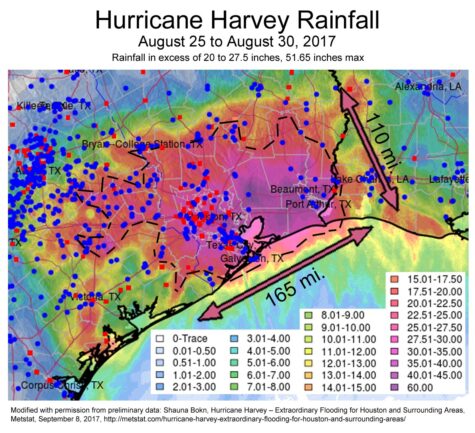
It has resulted in an increase in the number of people and value of property at risk to flooding.

In part this expansion is driven by population growth. This needs to be seen in the context of rapid urban expansion in the area and is characterized by a loss in impervious cover. Coupled with sea level rise, climate change has resulted in more frequent and intense flooding, especially in coastal areas.

Two standard statistical analyses of the observations show that the probability for such an amount of rain has increased by a factor 2.6 (1.6 to 5.0) since 1900, or equivalently the amount of rainfall in such an event has increased by 18% (11% to 28%) since 1900.The chances of recording this much precipitation at any of 85 stations along the Gulf Coast is however much higher, at about 1 in 50 years. Return times at other stations between East Houston and Beaumont were almost as high. every 1200 yr at the station with the highest total amount of rainfall. The precipitation recorded on 19–20 September 2019 associated with Tropical Storm Imelda was extreme, expected only approx.Authorities have linked five deaths to the floods and over one thousand people had to be rescued, making this the worst storm in the area since Hurricane Harvey. Expect highs in the 70s and lows in the 50s.In mid-September 2019, torrential rainfall from Tropical Storm Imelda caused large-scale flooding in Southeast Texas. Severe weather is not expected at this time. NWS Fort Worth reported, “Rain/storm chances return Sunday night and will linger through Tuesday across parts of North and Central Texas. Currently, there’s no chance of severe weather next week. Temperatures will be in the 70s during the day and low 50s at night. Rain and storms are expected to hit North Texas Sunday night and last until Tuesday. Lower totals have been observed further north”. The highest totals have been across the Brazos Valley where some have received between 3-4″ of rain. NWS Fort Worth reported “Here’s a look at the radar estimated rainfall totals through 1 AM Friday morning. The weather center said most heavy rains were in the Brazos Valley and moving up the central region to North Texas. Rainfall should move east Saturday morning”. Locations across North Texas will see drastically lower rainfall totals, generally less than 0.25″. Additional rainfall across this area of 0.5-1.5″ is expected. Heavy rainfall may lead to areas of flooding across portions of Central Texas. The best chances for rainfall will occur south of the I-20 corridor.

NWS Fort Worth reported, “Cool, cloudy, and rainy conditions are expected to end the work week.

It’s also going to rain more on Saturday, with temperatures around the mid-’60s. DALLAS(KDAF)- Today, North Texas will get heavy rain in the afternoon, which could cause flooding.


 0 kommentar(er)
0 kommentar(er)
